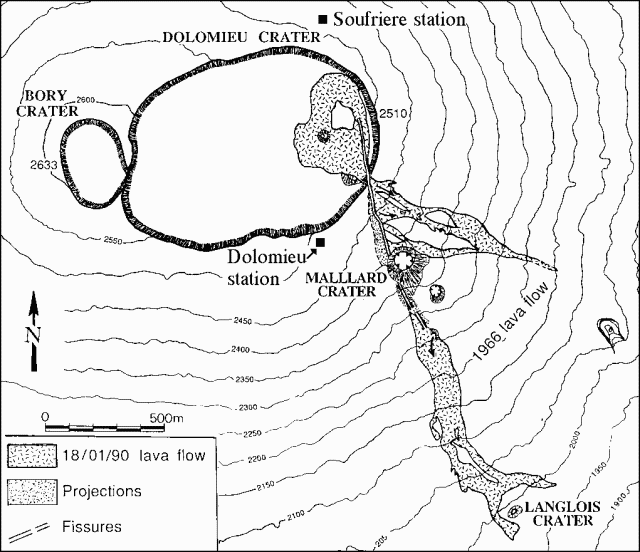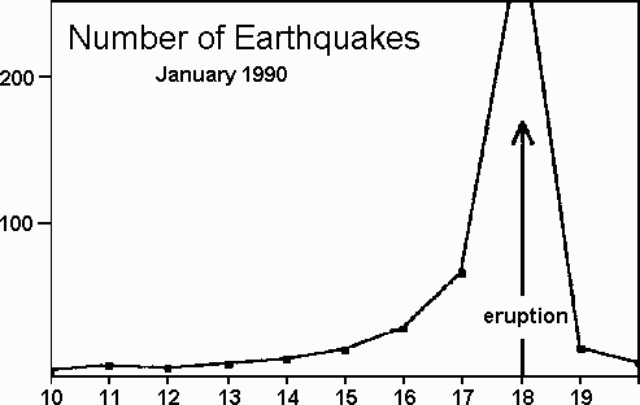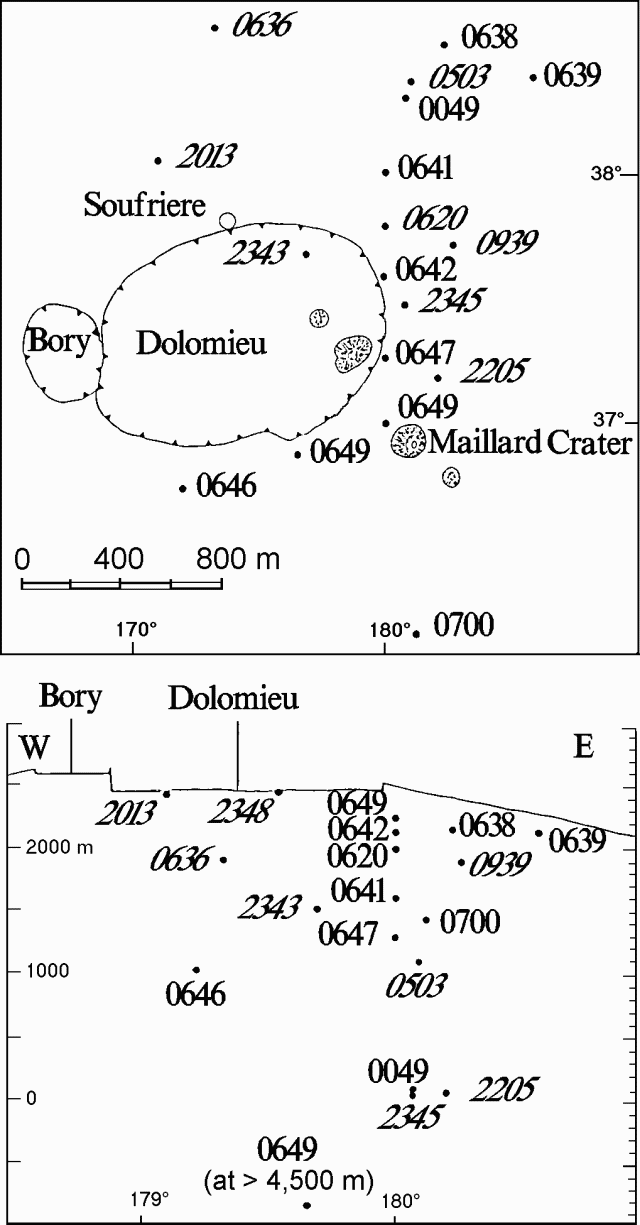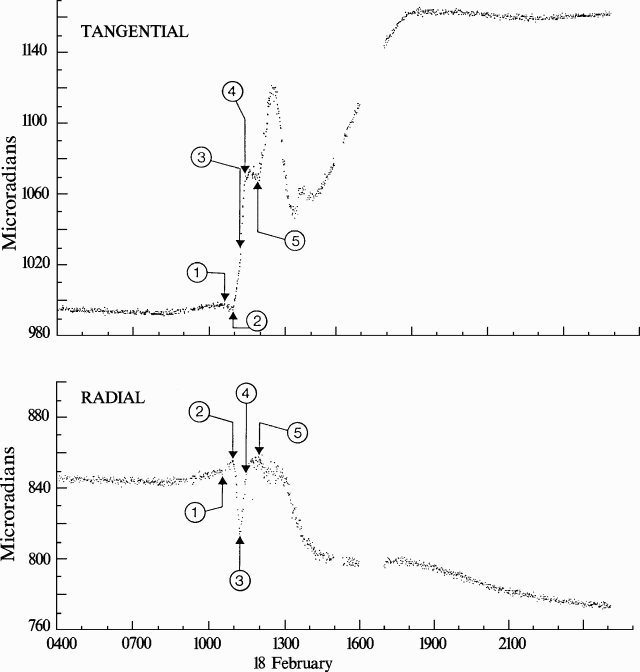Report on Piton de la Fournaise (France) — February 1990
Bulletin of the Global Volcanism Network, vol. 15, no. 2 (February 1990)
Managing Editor: Lindsay McClelland.
Piton de la Fournaise (France) Lava fountains and flows from summit-area fissure, with seismicity and deformation
Please cite this report as:
Global Volcanism Program, 1990. Report on Piton de la Fournaise (France) (McClelland, L., ed.). Bulletin of the Global Volcanism Network, 15:2. Smithsonian Institution. https://doi.org/10.5479/si.GVP.BGVN199002-233020
Piton de la Fournaise
France
21.244°S, 55.708°E; summit elev. 2632 m
All times are local (unless otherwise noted)
Both short- and long-period seismic events were recorded in the months preceding the eruption. Most were located below the summit, with some below the volcano's E flank (Grandes Pentes area). Three seismic swarms, each with >25 shocks, occurred in September and October, but no deformation or surface changes were noted. The number of seismic events (figure 21) increased in the days before the eruption, with 32 and 69 shocks recorded on 16 and 17 January respectively, centered below the N flank of Dolomieu Crater (figure 22).
The eruptive crisis began at 0322 with a 4-5-minute swarm of 33 events. Seismicity then decreased until 1036, when a new swarm of short-period earthquakes (lasting 2-5 seconds with events ~15 seconds apart) was recorded. Deformation (figure 23) was observed from 1032 until 1052 at the Soufrière and Dolomieu tilt stations (7 and 19 µrads respectively), suggesting inflation centered on Dolomieu Crater. An 11-second shock was detected at 1048, followed by a new swarm recorded by the summit stations. Numerous collapses of the Dolomieu crater rim were observed, especially on the NE rim. From 1052 to 1112 a clear deflation pattern (45 µrads) through Dolomieu Crater was detected by the Soufrière tiltmeters, whereas the Dolomieu tiltmeters (on the S edge of Dolomieu Crater) suggested tilt towards the SW. Events of the second swarm were at first generally centered below Dolomieu's NE flank (1038-1042), then succeeding events moved below the SE flank. All were very shallow, the deepest ~1 km asl.
Tremor appeared at 1112 on summit stations, with discrete shocks continuing until 1120. Maximum tremor intensity occurred at approximately 1124, while Soufrière tiltmeters recorded a 58 µrad tilt toward the NNW, and Dolomieu tiltmeters recorded a >100 µrad tilt toward the NE. These seismic and deformation signals coincided with the opening of an eruptive fissure in Dolomieu Crater, seen at 1124 by geologists making distance measurements in the summit area.
The fissure trended roughly N170°E, feeding vigorous lava fountains ~30 m high, and mainly aa flows that covered roughly 20% of Dolomieu's crater floor. The fissure rapidly propagated S towards Dolomieu's crater rim, then towards Maillard crater (figure 24). Lava fountains also occurred from the fissure extension, and lava emerged from the base of Maillard crater. After reaching Maillard Crater, the fissure progressively migrated NNW within Dolomieu Crater, to near the N crater rim. Fissure migration was accompanied by local SW tilting, recorded by the Soufrière station, whereas no significant motion was detected by Dolomieu tiltmeters. Eruptive spatter cones were aligned along this section of the fissure, which produced strong gas emissions and ejected lava fragments. Tremor remained at a significant level until 1730, then progressively decreased. Another seismic swarm occurred at 0244 before tremor ceased completely at 0630 on 19 January.
 |
Figure 24. Sketch map of the summit area at Piton de la Fournaise, showing the lava flows, main fractures, and the approximate positions of the Soufriere and Dolomieu tilt stations. |
During this brief eruption (~17 hours), <1 x 106 m3 of aphyric lava was emitted, with a mean calculated lava output rate of ~14 m3/s. Geologists noted that geodetic measurements could be interpreted in terms of an E-dipping dike injection.
Geological Summary. Piton de la Fournaise is a massive basaltic shield volcano on the French island of Réunion in the western Indian Ocean. Much of its more than 530,000-year history overlapped with eruptions of the deeply dissected Piton des Neiges shield volcano to the NW. Three scarps formed at about 250,000, 65,000, and less than 5,000 years ago by progressive eastward slumping, leaving caldera-sized embayments open to the E and SE. Numerous pyroclastic cones are present on the floor of the scarps and their outer flanks. Most recorded eruptions have originated from the summit and flanks of Dolomieu, a 400-m-high lava shield that has grown within the youngest scarp, which is about 9 km wide and about 13 km from the western wall to the ocean on the E side. More than 150 eruptions, most of which have produced fluid basaltic lava flows, have occurred since the 17th century. Only six eruptions, in 1708, 1774, 1776, 1800, 1977, and 1986, have originated from fissures outside the scarps.
Information Contacts: J. Toutain and P. Taochy, OVPDLF; P. Bachelery, Univ de la Reunion; J-L. Cheminée, IPGP. Field observations are fromP. Kowalski, A. Mussard, P. Piquemal, and P. Taochy (OVPDLF); P. Mairine, and A. Talibart.




